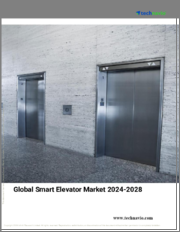
|
시장보고서
상품코드
1516949
세계의 창고용 화물 엘리베이터 시장 평가 : 유형별, 용도별, 판매 채널별, 속도별, 지역별, 기회 및 예측(2017-2031년)Warehouse Freight Elevators Market Assessment, By Type By Application, By Sales Channel, By Speed, By Region, Opportunities and Forecast, 2017-2031F |
||||||
세계 창고용 화물 엘리베이터 시장 규모는 2023년 70억 6,000만 달러에서 2031년 118억 4,000만 달러에 달할 것으로 예상되며, 2024-2031년 예측 기간 동안 연평균 6.68% 성장할 것으로 예상됩니다.
물류 및 창고 시설에서 효율적이고 안전한 화물 취급에 대한 수요가 증가하고 있습니다. 친환경적이고 지속가능한 솔루션에 대한 수요가 증가함에 따라 제조업체들은 재생 모터, 에너지 효율이 높은 LED 조명 등의 기능을 갖춘 첨단 창고용 화물 엘리베이터를 개발하고 있습니다. 특정 자재 취급 요구를 충족시키기 위해 창고용 화물 엘리베이터가 점점 더 많이 요구되고 있습니다. 제조업체들은 소비자의 다양한 수요를 충족시키기 위해 다양한 적재량, 도어 구성 및 플랫폼 크기의 장비를 생산하고 있으며, IoT 및 인더스트리 4.0 기술의 창고용 화물 엘리베이터에 대한 사용 증가는 시장 성장으로 이어질 것으로 보입니다. 센서, 카메라, 실시간 모니터링 시스템을 통해 자재 취급 프로세스가 더욱 효율적이고 안전해지고 있습니다.
에너지 효율이 높은 산업용 엘리베이터는 시장 성장에 부가가치를 더할 것으로 예상됩니다. 지속가능성이 중요해짐에 따라 기업들은 전력 소비와 발열이 적은 에너지 효율이 높은 엘리베이터를 선호하고 있습니다. 예를 들어, 엘리베이터가 하강할 때 발생하는 에너지는 회생 드라이브를 통해 회수 및 축적되어 상승할 때 사용할 수 있습니다.
예를 들어, 2022년 4월 알리막 그룹은 검증된 랙 앤 피니언 기술을 기반으로 한 새로운 산업용 엘리베이터 제품군을 발표했습니다. 완전히 새로운 ALIMAK SL-H는 항만, 조선소, 제철소, 광산, 제조, 창고, 물류센터 등 까다로운 운영 환경에 적합한 화물용 엘리베이터입니다.
산업 자동화 및 공간 최적화에 대한 수요가 시장 성장을 촉진
로봇 보관 및 검색 시스템, 컨베이어, 창고 내 여러 층 사이를 이동하는 분류 시스템과 같은 자동화 기술을 도입함에 따라 신뢰할 수 있고 효과적인 화물 엘리베이터가 점점 더 많이 요구되고 있습니다. 팔레트, 장비, 벌크 상품 등 크고 무겁고 부피가 큰 물품은 자동화된 창고에서 자주 취급됩니다. 크고 무거운 화물을 안전하고 안정적으로 층간 이동시키기 위해 화물 엘리베이터는 필수적인 옵션입니다. 창고용 화물 엘리베이터를 다른 자동화 기술과 통합하면 수작업을 최소화하고 상품 흐름을 강화하며 자재 취급 절차를 간소화할 수 있습니다. 이를 통해 생산량을 늘리고 주문 처리 속도를 높이며 전반적인 효율성을 높일 수 있습니다.
화물용 엘리베이터와 창고 자동화를 함께 사용하면 수작업으로 자재를 취급할 필요가 없기 때문에 인건비를 절감할 수 있습니다. 비용 효율성이 높아져 기업은 더 가치 있는 일에 인력을 투입할 수 있습니다. 빠른 배송시간과 다양한 제품 사이즈는 E-Commerce의 성장을 가져옵니다. 창고는 화물 엘리베이터의 도움으로 다양한 물품을 처리할 수 있으며, 상품의 효과적인 이동을 촉진하여 E-Commerce의 요구를 충족시킬 수 있습니다.
세계 시장의 산업화 확대와 기술 발전
창고용 화물용 엘리베이터는 창고에서 무거운 짐, 팔레트, 벌크 자재를 운반하는 데 도움이 되기 때문에 매우 중요합니다. 화물용 엘리베이터는 승객용 엘리베이터보다 더 큰 적재량으로 설계되어 더 열악한 환경에서도 작동할 수 있습니다. 창고용 화물 엘리베이터 산업이 확대되는 주요 이유는 산업 경영의 증가와 기술 발전입니다. 기업이 보관 요구 사항을 확장 할 때, 특히 E-Commerce 및 물류 분야 등에서 운송 절차를 가속화 할 가능성이 높으며, 이는 근로자 비용을 절감하고 더 나은 운영 시스템을 강화하는 데 더욱 도움이 될 것입니다.
유압식 수화물의 높은 효율과 효과로 부문 성장을 촉진
유압식 수하물 부문이 세계 창고용 화물 엘리베이터 시장을 주도하고 있습니다. 유압식 엘리베이터는 창고에서 큰 짐을 들어 올리는 데 적합합니다. 유압식 엘리베이터는 크고 무거운 물체를 층간 이동시킬 때 유체에 의해 추진되는 리프트 카가 매우 안정적이고 효율적입니다. 다른 유형에 비해 상대적으로 저렴하고 컴팩트합니다. 설치가 간단하고 별도의 기계실이 필요하지 않기 때문에 작은 창고에서 유용합니다. 유압식 엘리베이터를 사용하면 무겁고 큰 짐을 쉽게 들어 올려 창고 층 사이를 이동할 수 있습니다. 유압 시스템의 힘과 안정성으로 인해 큰 화물도 안정적으로 이동할 수 있습니다.
이 보고서는 세계 창고용 화물 엘리베이터 시장에 대해 조사 분석했으며, 시장 규모와 예측, 시장 역학, 주요 기업 현황 및 전망 등을 제공합니다.
목차
제1장 조사 방법
제2장 프로젝트 범위와 정의
제3장 주요 요약
제4장 고객의 소리
- 제품과 시장 정보
- 브랜드 인지 방식
- 구입 결정에서 고려되는 요소
- 프라이버시와 안전 규제 고려
제5장 세계의 창고용 화물 엘리베이터 시장 전망(2017-2031년)
- 시장 규모와 예측
- 금액
- 수량
- 유형별
- 유압식
- 기어 트랙션
- 기어리스 트랙션
- 기타
- 용도별
- 공장 창고
- 물류 센터
- 공항
- 기타
- 판매 채널별
- 직접
- 간접
- 속도별
- 0.5 m/s 미만
- 0.5-1 m/s
- 1 m/s 이상
- 지역별
- 북미
- 유럽
- 아시아태평양
- 남미
- 중동 및 아프리카
- 시장 점유율 : 기업별(2023년)
제6장 세계의 창고용 화물 엘리베이터 시장 전망 : 지역별(2017-2031년)
- 북미
- 시장 규모와 예측
- 유형별
- 용도별
- 판매 채널별
- 속도별
- 미국
- 캐나다
- 멕시코
- 유럽
- 독일
- 프랑스
- 이탈리아
- 영국
- 러시아
- 네덜란드
- 스페인
- 터키
- 폴란드
- 아시아태평양
- 인도
- 중국
- 일본
- 호주
- 베트남
- 한국
- 인도네시아
- 필리핀
- 남미
- 브라질
- 아르헨티나
- 중동 및 아프리카
- 사우디아라비아
- 아랍에미리트
- 남아프리카공화국
제7장 시장 매핑(2023년)
- 유형별
- 용도별
- 판매 채널별
- 속도별
- 지역별
제8장 거시적 환경과 산업 구조
- 수급 분석
- 수출입 분석
- 밸류체인 분석
- PESTEL 분석
- Porter's Five Forces 분석
제9장 시장 역학
- 성장 촉진요인
- 성장 억제요인(과제, 제한)
제10장 주요 기업 : 상황
- 시장 리더 상위 5개사 경쟁 매트릭스
- 시장 리더 상위 5개사 시장 매출 분석(2023년)
- 인수합병/합작투자(해당되는 경우)
- SWOT 분석(시장 기업 5개사)
- 특허 분석(해당되는 경우)
제11장 가격 분석
제12장 사례 연구
제13장 주요 기업 전망
- Fujitec Co. Ltd.
- Hitachi Ltd.
- Hyundai Elevator Co., Ltd.
- KONE Oyj
- Orona Group
- Schindler Group
- Toshiba Corporation
- ThyssenKrupp AG
- Mitsubishi Electric Corporation
- Otis Worldwide Corporation.
제14장 전략적 추천
제15장 당사 소개와 면책사항
ksm 24.07.30Global warehouse freight elevator market is projected to witness a CAGR of 6.68% during the forecast period of 2024-2031, growing from USD 7.06 billion in 2023 to USD 11.84 billion in 2031.
There is a rising demand from logistics and warehousing facilities for efficient and safe cargo handling. In response to the growing demand for environmentally friendly and sustainable solutions, manufacturers are developing highly advanced warehouse freight elevators equipped with features such as regenerative motors and energy-efficient LED lighting. Specialized warehouse freight elevators are becoming increasingly necessary to fulfill specific material handling needs. To meet the wide range of consumer demands, manufacturers produce devices with different weight capacities, door configurations, and platform sizes. Increasing use of the Internet of Things (IoT) and Industry 4.0 technologies in warehouse freight elevators leads to market growth. The material handling process is becoming more efficient and safer due to sensors, cameras, and real-time monitoring systems.
The advanced energy-efficient industrial elevators are anticipated to add value to the market growth. Companies are prioritizing energy-efficient elevators which use less power and produce less heat since sustainability has become essential. For instance, energy generated during the elevator's fall can be captured and stored by regenerative drives for use during the ascent.
For instance, in April 2022, built on the tried-and-true rack and pinion technology, the Alimak Group introduced a new line of industrial elevators. The brand-new ALIMAK SL-H is a freight and passenger elevator that is ideal for demanding operational settings such as ports, shipyards, steelworks, mines, manufacturing, storage, and logistics centers.
Industrial Automation and Demand for Space Optimization to Fuel the Market Growth
Reliable and effective freight elevators are becoming more necessary as warehouses implement automation technologies such as robotic storage and retrieval systems, conveyors, and sortation systems to transfer goods between different levels of the warehouse. Large, hefty, and bulky things like pallets, equipment, and bulk commodities are frequently handled by automated warehouses. For the safe and secure movement of large, heavy items between floors, freight elevators are an indispensable option. Warehouses minimize manual labor, enhancing the flow of goods, and streamlining material handling procedures by integrating freight elevators with other automated technology. It boosts output, expedites order processing, and enhances overall effectiveness.
When freight elevators and warehouse automation are used together, labor expenses can be decreased as manual material handling is no longer necessary. It boosts cost-effectiveness and enables businesses to devote more human resources to higher-value jobs. Rapid delivery times and wide range of product sizes resulting in the growth of e-commerce. Warehouses can handle a large variety of things with the help of freight elevators, which facilitates the effective movement of goods to satisfy e-commerce needs.
For instance, Jinan Juxin Machinery Co. Ltd. offers customized electric vertical warehouse hydraulic cargo lifter goods lift freight elevators with applications such as workshop cranes, warehouse cranes, and building cranes. The customization can be done based on load capacity, lifting height, and platform size.
Industrialization Expansion and Technological Advancements in the Global Market
Warehouse freight elevators are very important as they help carry heavy loads, pallets, and bulk materials in warehouse buildings. A freight elevator is designed with a greater load capacity and can operate in more severe environments than possible for passenger elevators. The rise in industrial operations and the development of technology are the main reasons why there is an expansion of warehouse freight elevator industry. When companies expand with their storage requirements, especially in e-commerce and logistics divisions, they are likely to fasten the transportation procedures, further helping to cut down on their costs for workers and enhance better operation systems in place.
For instance, Jinan Nostec Equipment Co. Ltd. delivers a 1000-kg hydraulic small cargo lift freight elevator goods lift for the warehouse. To maintain the platform's level with the ground, the compact freight lift can be connected to the pit. If pits are not permitted, it can provide a single permanent ramp for easy loading and unloading operations.
Higher Efficiency and Effectiveness of Hydraulic Freight to Fuel Segmental Growth
The hydraulic freight segment leads the global warehouse freight elevators market. For lifting large items in warehouses, hydraulic elevators are a good choice. When moving big, heavy objects between levels, they are dependable and efficient since the lift car is propelled by fluid. When compared to other kinds, these are comparatively cheap and compact. They are helpful in small warehouses since they are easy to install and do not need a separate machine room. Heavy and large objects are easily lifted and moved between floors of warehouses using hydraulic elevators. Large loads may be moved securely due to the force and stability offered by the hydraulic system.
Compared to other elevator types, hydraulic freight elevators are very cheap to install and run. They save money and space as they don't need a separate machine room. By offering a dependable and regulated means of transferring large objects, hydraulic elevators improve worker safety by lowering the possibility of accidents from manual handling. The main drivers propelling the hydraulic elevator segment's growth in the warehouse freight elevator market are its affordability, efficiency, and capacity to handle big loads.
For instance, Saksham Elevators Ltd. offers its 7.5-HP hydraulic freight elevator for warehouses and factories while having a capacity of 2 to 3 tons. The high load-bearing capacity comes with easy maintenance and minimum energy consumption.
North America Dominates Global Warehouse Freight Elevators Market Share
North America leads the market landscape with rising industrialization, investment in machines to limit the workforce, and higher penetration of automation technology. Furthermore, the expanded e-commerce businesses in the region have fueled the number of warehouses in the United States and Canada. The rising demand for products in the United States has prompted the need for more automated and efficient material handling equipment such as freight elevators, contributing to the growth of the market. In summary, North America is now the leader in the warehouse freight elevator market, led by the United States, due to a combination of factors such as the growing e-commerce and logistics industries, rising product demand, and the requirement for effective material handling equipment.
A brand based out of the United States, Otis Worldwide Corporation offers goods lift in commercial spaces. These freight elevators are major in heavy duty loading and unloading while tackling with hard technical constraints.
Future Market Scenario (2024 - 2031F)
Expanding e-commerce spaces advances in elevator technology and a range of verticals are expected to fuel warehouse freight elevators market growth.
New companies, limiting their manpower, are focusing more on automated tools and machines, anticipated to propel the market expansion.
Highly efficient capabilities, customization, and specialty solutions are projected to garner the market growth.
Key Players: Landscape and Outlook
Key participants in the warehouse freight elevator market focus on integrating efficient technology such as Internet of Things and artificial intelligence. Alongside, strategic partnerships, collaboration, acquisitions, and product launches are used as the major elements of the market's strategic landscape.
In June 2023, the Gen3 Core elevator, the newest model in the Gen3TM family of digitally native elevators, was unveiled by Otis Worldwide Corporation with the express purpose of catering to the expanding two-to-six-story building market in North America.
Table of Contents
1. Research Methodology
2. Project Scope and Definitions
3. Executive Summary
4. Voice of Customer
- 4.1. Product and Market Intelligence
- 4.2. Mode of Brand Awareness
- 4.3. Factors Considered in Purchase Decisions
- 4.3.1. Load Capacity
- 4.3.2. Platform Size
- 4.3.3. Vertical Travel Distance
- 4.3.4. Customization
- 4.3.5. Safety Features
- 4.3.6. Reliability and Maintenance
- 4.3.7. Integration with Automation Systems
- 4.4. Consideration of Privacy and Safety Regulations
5. Global Warehouse Freight Elevators Market Outlook, 2017-2031F
- 5.1. Market Size & Forecast
- 5.1.1. By Value
- 5.1.2. By Volume
- 5.2. By Type
- 5.2.1. Hydraulic
- 5.2.2. Geared Traction
- 5.2.3. Gearless Traction
- 5.2.4. Others
- 5.3. By Application
- 5.3.1. Factory Warehouse
- 5.3.2. Logistic Center
- 5.3.3. Airport
- 5.3.4. Others
- 5.4. By Sales Channel
- 5.4.1. Direct
- 5.4.2. Indirect
- 5.5. By Speed
- 5.5.1. Below 0.5 m/s
- 5.5.2. Between 0.5 and 1 m/s
- 5.5.3. Above 1 m/s
- 5.6. By Region
- 5.6.1. North America
- 5.6.2. Europe
- 5.6.3. Asia-Pacific
- 5.6.4. South America
- 5.6.5. Middle East and Africa
- 5.7. By Company Market Share (%), 2023
6. Global Warehouse Freight Elevators Market Outlook, By Region, 2017-2031F
- 6.1. North America*
- 6.1.1. Market Size & Forecast
- 6.1.1.1. By Value
- 6.1.1.2. By Volume
- 6.1.2. By Type
- 6.1.2.1. Hydraulic
- 6.1.2.2. Geared Traction
- 6.1.2.3. Gearless Traction
- 6.1.2.4. Others
- 6.1.3. By Application
- 6.1.3.1. Factory Warehouse
- 6.1.3.2. Logistic Center
- 6.1.3.3. Airport
- 6.1.3.4. Others
- 6.1.4. By Sales Channel
- 6.1.4.1. Direct
- 6.1.4.2. Indirect
- 6.1.5. By Speed
- 6.1.5.1. Below 0.5 m/s
- 6.1.5.2. Between 0.5 and 1 m/s
- 6.1.5.3. Above 1 m/s
- 6.1.6. United States*
- 6.1.6.1. Market Size & Forecast
- 6.1.6.1.1. By Value
- 6.1.6.1.2. By Volume
- 6.1.6.2. By Type
- 6.1.6.2.1. Hydraulic
- 6.1.6.2.2. Geared Traction
- 6.1.6.2.3. Gearless Traction
- 6.1.6.2.4. Others
- 6.1.6.3. By Application
- 6.1.6.3.1. Factory Warehouse
- 6.1.6.3.2. Logistic Center
- 6.1.6.3.3. Airport
- 6.1.6.3.4. Others
- 6.1.6.4. By Sales Channel
- 6.1.6.4.1. Direct
- 6.1.6.4.2. Indirect
- 6.1.6.5. By Speed
- 6.1.6.5.1. Below 0.5 m/s
- 6.1.6.5.2. Between 0.5 and 1 m/s
- 6.1.6.5.3. Above 1 m/s
- 6.1.6.1. Market Size & Forecast
- 6.1.7. Canada
- 6.1.8. Mexico
- 6.1.1. Market Size & Forecast
All segments will be provided for all regions and countries covered
- 6.2. Europe
- 6.2.1. Germany
- 6.2.2. France
- 6.2.3. Italy
- 6.2.4. United Kingdom
- 6.2.5. Russia
- 6.2.6. Netherlands
- 6.2.7. Spain
- 6.2.8. Turkey
- 6.2.9. Poland
- 6.3. Asia-Pacific
- 6.3.1. India
- 6.3.2. China
- 6.3.3. Japan
- 6.3.4. Australia
- 6.3.5. Vietnam
- 6.3.6. South Korea
- 6.3.7. Indonesia
- 6.3.8. Philippines
- 6.4. South America
- 6.4.1. Brazil
- 6.4.2. Argentina
- 6.5. Middle East and Africa
- 6.5.1. Saudi Arabia
- 6.5.2. UAE
- 6.5.3. South Africa
7. Market Mapping, 2023
- 7.1. By Type
- 7.2. By Application
- 7.3. By Sales Channel
- 7.4. By Speed
- 7.5. By Region
8. Macro Environment and Industry Structure
- 8.1. Demand-Supply Analysis
- 8.2. Import-Export Analysis
- 8.3. Value Chain Analysis
- 8.4. PESTEL Analysis
- 8.4.1. Political Factors
- 8.4.2. Economic System
- 8.4.3. Social Implications
- 8.4.4. Technological Advancements
- 8.4.5. Environmental Impacts
- 8.4.6. Legal Compliances and Regulatory Policies (Statutory Bodies Included)
- 8.5. Porter's Five Forces Analysis
- 8.5.1. Supplier Power
- 8.5.2. Buyer Power
- 8.5.3. Substitution Threat
- 8.5.4. Threat from New Entrant
- 8.5.5. Competitive Rivalry
9. Market Dynamics
- 9.1. Growth Drivers
- 9.2. Growth Inhibitors (Challenges and Restraints)
10. Key Players: Landscape
- 10.1. Competition Matrix of Top Five Market Leaders
- 10.2. Market Revenue Analysis of Top Five Market Leaders (By Value, 2023)
- 10.3. Mergers and Acquisitions/Joint Ventures (If Applicable)
- 10.4. SWOT Analysis (For Five Market Players)
- 10.5. Patent Analysis (If Applicable)
11. Pricing Analysis
12. Case Studies
13. Key Players Outlook
- 13.1. Fujitec Co. Ltd.
- 13.1.1. Company Details
- 13.1.2. Key Management Personnel
- 13.1.3. Products and Services
- 13.1.4. Financials (As Reported)
- 13.1.5. Key Market Focus and Geographical Presence
- 13.1.6. Recent Developments
- 13.2. Hitachi Ltd.
- 13.3. Hyundai Elevator Co., Ltd.
- 13.4. KONE Oyj
- 13.5. Orona Group
- 13.6. Schindler Group
- 13.7. Toshiba Corporation
- 13.8. ThyssenKrupp AG
- 13.9. Mitsubishi Electric Corporation
- 13.10. Otis Worldwide Corporation.
Companies mentioned above DO NOT hold any order as per market share and can be changed as per information available during research work.



















